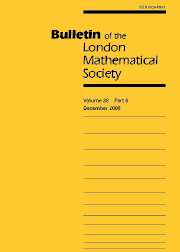Crossref Citations
This article has been cited by the following publications. This list is generated based on data provided by Crossref.
Muzychuk, Mikhail
and
Ponomarenko, Ilia
2009.
Schur rings.
European Journal of Combinatorics,
Vol. 30,
Issue. 6,
p.
1526.
Christopher, C.
and
Mardešić, P.
2010.
The monodromy problem and the tangential center problem.
Functional Analysis and Its Applications,
Vol. 44,
Issue. 1,
p.
22.
Кристофер, К
Christopher, C
Мардешич, Павао
and
Mardesic, Pavao
2010.
Проблема монодромии и инфинитезимальная проблема фокуса.
Функциональный анализ и его приложения,
Vol. 44,
Issue. 1,
p.
27.
Evdokimov, Sergei
and
Ponomarenko, Ilya
2010.
Schur rings over a Galois ring of odd characteristic.
Journal of Combinatorial Theory, Series A,
Vol. 117,
Issue. 7,
p.
827.
Evdokimov, Sergei
and
Ponomarenko, Ilya
2016.
Coset closure of a circulant S-ring and schurity problem.
Journal of Algebra and Its Applications,
Vol. 15,
Issue. 04,
p.
1650068.
Muzychuk, M. E.
Ponomarenko, I. N.
and
Chen, G.
2016.
The Schur–Wielandt Theory for Central S-Rings.
Algebra and Logic,
Vol. 55,
Issue. 1,
p.
38.
Muzychuk, M. E.
and
Ponomarenko, I. N.
2016.
On Schur 2-Groups.
Journal of Mathematical Sciences,
Vol. 219,
Issue. 4,
p.
565.
Nedela, Roman
and
Ponomarenko, Ilia
2020.
Isomorphisms, Symmetry and Computations in Algebraic Graph Theory.
Vol. 305,
Issue. ,
p.
195.
Alvarez, Amelia
Bravo, Jose Luis
Christopher, C
and
Mardesić, Pavao
2021.
Инфинитезимальная проблема центра на нулевых циклах и гипотеза композиции.
Функциональный анализ и его приложения,
Vol. 55,
Issue. 4,
p.
3.
Álvarez, A.
Bravo, J. L.
Christopher, C.
and
Mardešić, P.
2021.
Infinitesimal Center Problem on Zero Cycles and the Composition Conjecture.
Functional Analysis and Its Applications,
Vol. 55,
Issue. 4,
p.
257.

